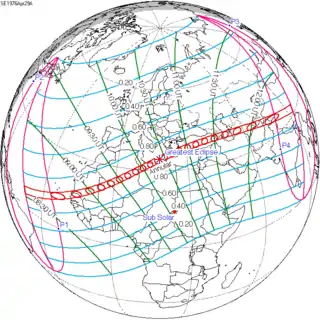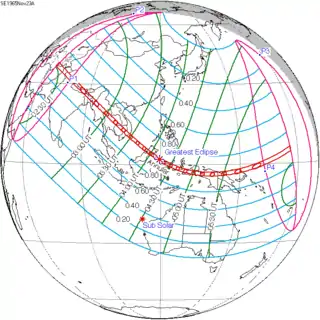| Solar eclipse of April 19, 1958 | |
|---|---|
 Map | |
| Type of eclipse | |
| Nature | Annular |
| Gamma | 0.275 |
| Magnitude | 0.9408 |
| Maximum eclipse | |
| Duration | 427 sec (7 m 7 s) |
| Coordinates | 26°30′N 123°36′E / 26.5°N 123.6°E |
| Max. width of band | 228 km (142 mi) |
| Times (UTC) | |
| Greatest eclipse | 3:27:17 |
| References | |
| Saros | 128 (55 of 73) |
| Catalog # (SE5000) | 9416 |
An annular solar eclipse occurred on April 19, 1958. A solar eclipse occurs when the Moon passes between Earth and the Sun, thereby totally or partly obscuring the image of the Sun for a viewer on Earth. An annular solar eclipse occurs when the Moon's apparent diameter is smaller than the Sun's, blocking most of the Sun's light and causing the Sun to look like an annulus (ring). An annular eclipse appears as a partial eclipse over a region of the Earth thousands of kilometres wide. Annularity was visible in the Maldives, Nicobar Islands, Burma, Thailand including the capital city Bangkok, Cambodia, Laos, North Vietnam and South Vietnam (now belonging to Vietnam), China, British Hong Kong, Taiwan, Ryukyu Islands and Japan. It was the fourth central solar eclipse visible from Bangkok from 1948 to 1958, where it is rare for a large city to witness 4 central solar eclipses in just 9.945 years. Places east of International Date line witnessed the eclipse on April 18 (Friday).
Observation
Compared with a total solar eclipse, the chromosphere, corona and solar prominence are invisible during an annular eclipse. However, observations of millimeter-wave solar radio can provide data for lower- and mid-layer structure of the chromosphere, which is more valuable during an annular solar eclipse.[1]
China
A joint observation team formed by the Academy of Sciences of the Soviet Union (predecessor of today's Russian Academy of Sciences) and the Chinese Academy of Sciences conducted 8-millimeter radio observation in Sanya, Hainan Island, China using the equatorial parabolic radio telescope manufactured by the Lebedev Physical Institute and the dual-channel radiometer as a receiver.[1][2] Radio astronomy started to develop from then in China.[3] Due to the Sino-Soviet split soon after this eclipse, the two countries did not conduct any joint observations of the total solar eclipse of September 22, 1968. On January 23, 1969, the People's Daily published an article reporting the observation of the eclipse in 1968, where it also criticized that the Soviet Union "plundered data of the annular solar eclipse" in 1958, only left China a "worn radio telescope antenna", and later even asked for it back.[4]
Japan
Observation ships were sent to Hachijō-jima, Izu Islands, Japan.[5] Pictures were also taken in Tanegashima, Osumi Islands, and luminosity, air pressure, temperature, humidity, water temperature of the storage tank, ground temperature, wind direction, wind speed and other data were recorded every 10 minutes.[6]
Related eclipses
Solar eclipses of 1957–1960
This eclipse is a member of a semester series. An eclipse in a semester series of solar eclipses repeats approximately every 177 days and 4 hours (a semester) at alternating nodes of the Moon's orbit.[7]
| Solar eclipse series sets from 1957–1960 | ||||
|---|---|---|---|---|
| Descending node | Ascending node | |||
| Saros | Map | Saros | Map | |
| 118 |  1957 April 30 Annular (non-central) |
123 |  1957 October 23 Total (non-central) | |
| 128 |  1958 April 19 Annular |
133 |  1958 October 12 Total | |
| 138 |  1959 April 8 Annular |
143 |  1959 October 2 Total | |
| 148 |  1960 March 27 Partial |
153 |  1960 September 20 Partial | |
Saros 128
This eclipse is a member of the Solar Saros cycle 128, which includes 73 eclipses occurring in intervals of 18 years and 11 days. The series started with partial solar eclipse on August 29, 984 AD. From May 16, 1417 through June 18, 1471 the series produced total solar eclipses, followed by hybrid solar eclipses from June 28, 1489 through July 31, 1543, and annular solar eclipses from August 11, 1561 through July 25, 2120. The series ends at member 73 as a partial eclipse on November 1, 2282. All eclipses in this series occurs at the Moon’s descending node.
| Series members 52–68 occur between 1901 and 2200 | ||
|---|---|---|
| 52 | 53 | 54 |
 March 17, 1904 |
 March 28, 1922 |
 April 7, 1940 |
| 55 | 56 | 57 |
 April 19, 1958 |
 April 29, 1976 |
 May 10, 1994 |
| 58 | 59 | 60 |
 May 20, 2012 |
 June 1, 2030 |
 June 11, 2048 |
| 61 | 62 | 63 |
 June 22, 2066 |
 July 3, 2084 |
 July 15, 2102 |
| 64 | 65 | 66 |
 July 25, 2120 |
August 5, 2138 (Partial) | August 16, 2156 (Partial) |
| 67 | 68 | |
| August 27, 2174 (Partial) | September 6, 2192 (Partial) | |
Tritos series
This eclipse is a part of a tritos cycle, repeating at alternating nodes every 135 synodic months (≈ 3986.63 days, or 11 years minus 1 month). Their appearance and longitude are irregular due to a lack of synchronization with the anomalistic month (period of perigee), but groupings of 3 tritos cycles (≈ 33 years minus 3 months) come close (≈ 434.044 anomalistic months), so eclipses are similar in these groupings.
| Series members between 1901 and 2100 | |||
|---|---|---|---|
 September 21, 1903 (Saros 123) |
 August 21, 1914 (Saros 124) |
 July 20, 1925 (Saros 125) | |
 June 19, 1936 (Saros 126) |
 May 20, 1947 (Saros 127) |
 April 19, 1958 (Saros 128) | |
 March 18, 1969 (Saros 129) |
 February 16, 1980 (Saros 130) |
 January 15, 1991 (Saros 131) | |
 December 14, 2001 (Saros 132) |
 November 13, 2012 (Saros 133) |
 October 14, 2023 (Saros 134) | |
 September 12, 2034 (Saros 135) |
 August 12, 2045 (Saros 136) |
 July 12, 2056 (Saros 137) | |
 June 11, 2067 (Saros 138) |
 May 11, 2078 (Saros 139) |
 April 10, 2089 (Saros 140) | |
 March 10, 2100 (Saros 141) |
|||
Metonic series
The metonic series repeats eclipses every 19 years (6939.69 days), lasting about 5 cycles. Eclipses occur in nearly the same calendar date. In addition, the octon subseries repeats 1/5 of that or every 3.8 years (1387.94 days). All eclipses in this table occur at the Moon's descending node.
| 22 eclipse events between September 12, 1931 and July 1, 2011. | ||||
|---|---|---|---|---|
| September 11-12 | June 30-July 1 | April 17-19 | February 4-5 | November 22-23 |
| 114 | 116 | 118 | 120 | 122 |
 September 12, 1931 |
 June 30, 1935 |
 April 19, 1939 |
 February 4, 1943 |
 November 23, 1946 |
| 124 | 126 | 128 | 130 | 132 |
 September 12, 1950 |
 June 30, 1954 |
 April 19, 1958 |
 February 5, 1962 |
 November 23, 1965 |
| 134 | 136 | 138 | 140 | 142 |
 September 11, 1969 |
 June 30, 1973 |
 April 18, 1977 |
 February 4, 1981 |
 November 22, 1984 |
| 144 | 146 | 148 | 150 | 152 |
 September 11, 1988 |
 June 30, 1992 |
 April 17, 1996 |
 February 5, 2000 |
 November 23, 2003 |
| 154 | 156 | |||
 September 11, 2007 |
 July 1, 2011 | |||
Notes
- 1 2 Н. А. Аменицкий, 李征帆, А. Е. Саломонович, У. В. Хангильдин, 陳鈞量 (June 1959). "1958年4月19日日环食时8毫米太阳射电观测". 天文学报 (Acta Astronomica Sinica). 7 (1): 7–10.
{{cite journal}}: CS1 maint: multiple names: authors list (link) - ↑ "Кольцеобразное солнечное затмение 19 апреля 1958 года". Archived from the original on 10 August 2009.
- ↑ 储姗姗 (2013). "1958年中苏海南岛日食观测与中国射电天文学的开端". 2013中国天文学会学术年会文集.
- ↑ "用毛泽东思想探索太阳的奥秘——记我国首次大规模日全食综合观测队". People's Daily. 23 January 1969.
一九五八年苏修打着"中苏日环食联合观测"的幌子,来我国掠取日环食资料。观测结束后,把一台破烂不堪的射电望远镜天线留在中国,还美其名曰"帮助中国发展射电天文学"。后来,赫鲁晓夫修正主义集团把这个破烂的射电望远镜天线也要了回去。
- ↑ "トカラ列島を中心に長い金環日食". 日食ナビ. Archived from the original on 5 March 2016.
- ↑ "1958年(昭和33年)の金環日食". 鹿児島県天文協会 (Kagoshima Prefecture Astronomical Association). Archived from the original on 4 March 2016.
- ↑ van Gent, R.H. "Solar- and Lunar-Eclipse Predictions from Antiquity to the Present". A Catalogue of Eclipse Cycles. Utrecht University. Retrieved 6 October 2018.
.jpg.webp)

